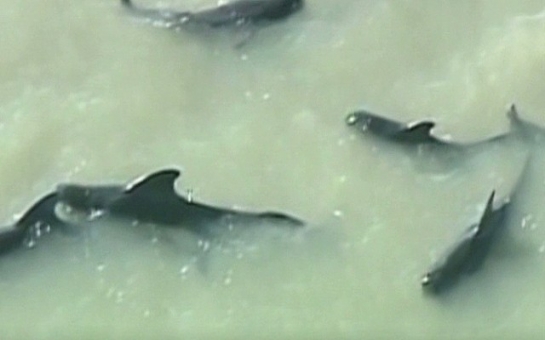"We want to set the expectations low" that the 41 remaining stranded whales can be saved, said Blair Mase, a marine mammal scientist with the National Oceanic and Atmospheric Administration.The assessment came as the number of dead whales climbed to 10, including four euthanized by wildlife officials after being found in "poor condition," Mase said.Wildlife officials are unsure how long the pod of whales has been stranded. Fishermen spotted the whales, several of which had beached themselves, on Tuesday night in a remote area accessible only by boat off the west coast of the Everglades, park spokeswoman Linda Friar said.An attempt earlier in the day to herd the whales out of the park's remote Highland Beach failed.Rescuers have been using five boats to create a blockade of sorts between the whales and the beach as part of the effort to keep them from beaching and simultaneously encouraging them to make their way back to the Gulf of Mexico, Friar said.Wildlife officials believe that it took the pilot whales several days to travel the 20 miles from the deep waters where they typically make their home to the shallow beach area where they were found.That area is blanketed with sandbars and sand flats."It's a very difficult situation" given the remote location and the terrain, Mase said.Although there is a slight possibility the whales could swim out during high tide, Mase said, "I wouldn't set out hope for that.""Even in high tide, you're going to have a series of sandbars and sand flats," she said.Necropsies were being performed to try to determine why the pod carried out a mass stranding."At this point in time, we don't know why this particular group is stranding," Mase said.In all, 25 people were involved in rescue efforts, including officials from NOAA, the Marine Mammal Conservatory and the Marine Animal Rescue Society, Mase said.Mass strandings by pilot whales are not altogether uncommon in Florida. In 2012, nearly two dozen pilot whales stranded and beached themselves. In 2011, 23 pilot whales stranded and beached themselves.Such strandings are common and occur in a variety of locations, said Phillip Clapham, director of the whale research program at the National Marine Mammal Laboratory in Seattle.It's difficult to explain why any particular mass stranding occurs, but they tend to occur in areas where previous strandings have occurred, during low tide -- particularly those around the new and full moons, in areas dotted with sand bars and during storms.The animals' cohesion can doom an entire group. "These are very, very social animals," Clapham said. "They remain together as family units. If the lead animal gets in trouble, probably everyone else is going to follow them and be in trouble."Would-be rescuers have their hands full, he said, noting that the animals can weigh a ton apiece. "It's a largely, but not entirely, hopeless undertaking," he said.Clapham noted that on Cape Cod in Massachusetts, where such strandings are routine events, rescuers have used cranes and a flatbed truck. But heavy equipment is not readily available in the remote area off the Everglades where the most recent stranding occurred.No good estimates exist for how many pilot whales exist, but they are not endangered, he said."These events, while they're tragic, don't have any implications for the survival of the species."Canadians rush to save 11 trapped killer whales(CNN)ANN.Az
Survival 'expectation low' for pilot whales stranded in Everglades park
World
10:26 | 06.12.2013

Survival 'expectation low' for pilot whales stranded in Everglades park
The outlook for dozens of short-finned pilot whales stranded in shallow water off Florida's Everglades National Park "does not look good," wildlife officials said Wednesday.
Follow us !










